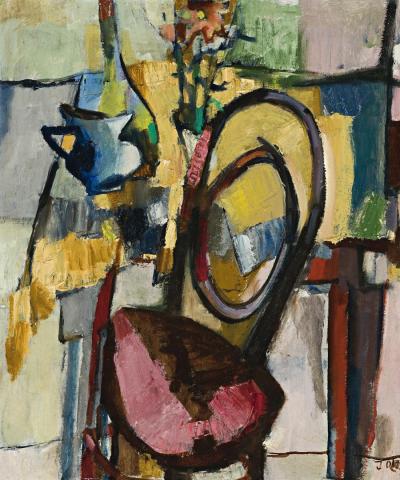STILL LIFE, 1954
JOHN OLSEN
oil on canvas
61.0 x 50.5 cm
signed lower right: J OLSEN
Macquarie Galleries, Sydney
Margo Snape, Sydney, acquired from the above in 1954
Private collection, Sydney, acquired from the above in 1985
Sydney Still Life, The Painters Gallery, Sydney, 17 June – 5 July 1986, cat. 25
When the young Turk becomes Australia's greatest living artist, one looks with different eyes at the youthful creations, seeing and admiring those first stirrings that made his art so great. So it is with John Olsen and his painting. He was just out of art school, having studied under John Passmore during 1948 to 1953, Still Life, 1954 being so redolent with the beneficial Passmore influence. But like all gifted people, it was the beginning from which he developed his own striking individuality, a vitality and vision today so readily identified with Australia and being Australian. The chair, table, jug and flowers are common props of still life painting. The high viewpoint looking down at the group gives opportunity to dispense with pictorial illusions of depth and ply the paint across the picture plane in patterns of colour and textured surfaces. The master of landscapes and still lifes, Cézanne, and Cubism comes to mind. As Deborah Hart in her monograph on Olsen has observed, 'Passmore's importance for Olsen as a teacher was felt not only in direct observations about drawing and painting, but also through his interest in literature.'1 Olsen became a hungry reader, his love of poetry still evident today in his writings and speaking. For Olsen, even the prosaic genre of still life, as in our painting, is given a poetic touch. The lively colours touch upon the lyrical; forms rhyme and repeat with a metered beat. The presence of a table, bottle and jug hint at the bon vivant to come, paintings titled Portuguese Kitchen, 1966 (two versions), and Duck à la Orange, 1981, with eggs as constant fertility symbols within the landscape talk a lot of one fond of food. One also recalls a bigger canvas of the time, Still Life with Boy, 1954 in the collection of the Newcastle Art Gallery, Newcastle being Olsen's birthplace. The table is loaded with preparations for a meal, a fish central to the scene.
Interwoven throughout our painting one can sense the personality of the artist, to grow so irrepressible in his later art and life, intoxicated with a sense of fun. The early fifties found figurative art sitting heavily on the Australian art scene, yet to be slowly but surely overwhelmed by abstract expressionism. Looking back through the telescope of history, one sees Still Life, 1954 as quite a bold achievement for its time. As his craft developed, the figurative eased into abstraction and freedom. The first triumph was the Bicycle Boys paintings of 1955, The Bicycle Boys being in the collection of the National Gallery of Australia, Canberra, and The Bicycle Boys Rejoice in the collection of James Fairfax, where it hangs alongside Passmore. A sense of fun and rejoicing is central to Olsen's art.
1. Hart, D., John Olsen, Craftsman House, Sydney, 1991, p. 14
DAVID THOMAS
